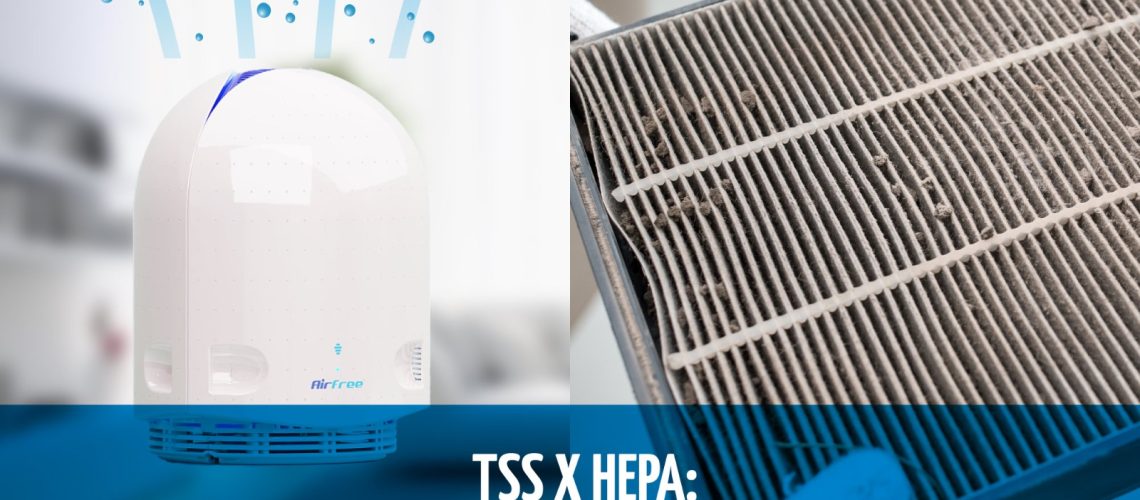TSS x HEPA
Introduction
Indoor air quality (IAQ) has become a growing concern due to the increasing awareness of airborne pollutants and their impact on health. Two popular technologies for air purification are Thermo-dynamic Sterilization Systems (TSS) and High-Efficiency Particulate Air (HEPA) filtration. In this article, we will compare TSS and HEPA air purifiers in terms of their principles, performance, advantages, and limitations.
HEPA Air Purifiers
Principle:
HEPA air purifiers use a dense filter made of fine fibers to capture airborne particles, including dust, pollen, pet dander, and microorganisms attached to particles. The filter traps particles as small as 0.3 microns with an efficiency of 99.97% or higher.
Performance:
Effectively removes particulate matter from the air.
Does not address gaseous pollutants or odors.
Advantages:
Proven and widely used technology.
Safe and chemical-free.
Disadvantages:
Expensive filters to be timely replaced.
Noisy operation
Potential room re-contamination when exchanging filters or turning the device off.
Environmental concerns due to disposal of hazardous used filters discarded in Landfills
TSS Air Purifiers
Principle:
TSS air purifiers employ heat to sterilize the air by raising the temperature to 400F inside the TSS ceramic core mini-ducts, effectively destroying microorganisms, bacteria, and viruses.
Some models are hybrid and include an exclusive Capsule System for the removal of particles and VOC’s.
Performance:
Efficiently destroys viruses, bacteria, mold spores, organic allergens, rather than just trapping them.
Hybrid models capture Particles and VOCs in addition to destroying microorganisms.
Advantages:
Efficiently destroys microorganisms at high temperature, with no heat transferring to the room.
No waste accumulation to Landfills with its silent operation on TSS.
Reduces the risk of infections and cross contamination
No need for filter replacement in the TSS mode
Limitations:
The regular models destroy microbial and pathogenic infestations but do not capture outdoor pollution infiltrating the room. The Hybrid models handle both tasks.
Comparison:
Both HEPA and the Airfree Hybrid models serve the same purpose, with the main difference being that the majority of the Elite operation will be in the silent and maintenance free TSS mode.
Effectiveness:
HEPA purifiers excel at removing particulate matter but do not provide air sterilization.
TSS purifiers excel at microbial destruction, making them suitable for highly sterile environments.
Range of Applications:
HEPA purifiers are suitable for general indoor air quality improvement.
TSS regular air purifiers are essential in environments where mold, bacteria, allergens and microorganism control are crucial. As for the iinfiltration outdoor pollution with the Hybrid models
Operating Costs:
HEPA purifiers have costly regular filter replacements.
TSS purifiers do not require filter changes on most of its models and small on the Hybrid models
Initial Investment:
HEPA purifiers of good quality of same capacity have a higher initial purchase cost.
TSS purifiers have a lower initial cost.
Conclusion
In summary, the choice between TSS and HEPA air purifiers depends on the specific needs of the indoor environment.
HEPA purifiers are suitable for general particle removal, while TSS purifiers are essential in home and office environments where mold, allergens, bacteria and viruses are critical and little concern with outdoor pollution infiltrating the spaces. When outdoor pollution really impacts indoor air, the Airfree Hybrid models are to be considered. Consider factors such as the type of pollutants present, the intended application, area, and purchase and maintenance budget constraints, when selecting the appropriate air purifier for your indoor space.


